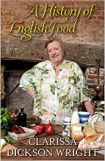A History of English Food by Clarissa Dickson Wright
| A History of English Food by Clarissa Dickson Wright | |
|
| |
| Category: History | |
| Reviewer: John Van der Kiste | |
| Summary: A superbly-researched and well-illustrated history of English food and drink from the 12th century to the present day, combining research and personal experience, from one of the most contemporary popular cookery writers and presenters. | |
| Buy? Yes | Borrow? Yes |
| Pages: 500 | Date: October 2011 |
| Publisher: Random House | |
| ISBN: 9781905211852 | |
| Video:
| |
Writing a history of English food, and to some extent drink, must be a daunting task, but as an experienced TV presenter (as one of the Two Fat Ladies with the late Jennifer Paterson) and as one who was born in the post-war rationing world in 1947, Clarissa Dickson Wright is well placed to do so.
As she says in her introduction, this is the book she always knew she would write one day. Her account is strictly chronological, taking a path through the centuries, from around 1150 to today. In the first chapter we learn about the importance to the larder of rabbits, pigeons, deer and fish, the later being particularly important as in medieval society, most people came out of winter suffering slightly from scurvy which could be cured by eating vegetables and fish. Pigs served a dual purpose in that they kept the streets clear of garbage and sewage that might otherwise have led to disease, as well as tidied up the London market sites afterwards, being sold or butchered once they had reached a suitable weight. (Before anyone says ‘health and safety’, the risk of tapeworm was overcome by proper cooking). Foreign cultures had an impact on English cookery since the days of the Crusades, when the soldiers brought back spices such as cinnamon and nutmeg, which feature strongly in The Forme of Cury, probably the first in a long list of cookery book titles, dating from around 1390.
Like a good cake, this book is stuffed with so many goodies that it is hard to know where to start, or what to include and what to leave out. Sack, or sherry, began an English love affair with the drink from the time of Catherine of Aragon, first wife of Henry VIII, onwards. Elizabeth I regularly issued proclamations encouraging people to eat fish on fast days in order to sustain England’s fishing fleet, and the celebration of Shrove Tuesday with pancakes was begun around the same time to use up milk and eggs before the Lenten fast began. Tea, coffee and drinking chocolate were first recorded in England during the 17th century, and Pepys’ diary is an invaluable source of various titbits of contemporary food and drink. The origins of fish and chips are still debated to this day, although we can say for certain that they began and rapidly caught on in mid-Victorian times (Dickens mentions a 'fried fish warehouse' in Oliver Twist), although both London and Lancashire claim the credit.
Mention is made of the famous characters who left their mark on English cuisine. Mrs Beeton was the major name of her day, although the author wonders whether all her recipes were tested before they went to print as some are far from appealing. A century later the celebrities were stars not of print but of TV, among them Philip Harben, Fanny Cradock (whose spectacular rudeness was quite amusing in small doses until she overstepped the bounds and in one programme managed to kill her broadcasting career stone dead), Graham Kerr and Delia Smith. The author herself could rightly claim her place in that hall of fame.
What particularly enlivens the last chapters of this book is the fact that the author or her parents were there, and can add some personal reminiscences to round off this superbly-researched labour of love. Her family can just recall how Britain’s dependence on imported food can be traced back to the end of the 19th century, as became severely apparent during the First World War. She remembers that food shortages and rationing paradoxically worsened after the Second World War, with coupons for sugar and sweets in force until the Queen’s coronation in 1953. Also part of her adolescent years were the coffee bars, which were everywhere in the 1950s but almost a thing of the past by the 1990s, when she visited one of the last surviving ones in Swansea, still with linoleum-covered tables and coffee which had still not improved from the early days.
She does not shrink from pointing out that not everything has improved with the modern age. During wartime, rabbit was an obvious choice for the pot, and the deliberate importation of the myxomatosis virus from Australia a decade later was devastating, with the result that useful meat largely vanished from the national diet. Many would agree with her that the big supermarkets have much to answer for in the loss of variety and traditional foods and that with pot noodles and ready meals we have ceased to be a nation of cooks and are now a nation of food preparers. Above all, she castigates governmental mishandling of the foot and mouth outbreak of 2001 and the fact that a DEFRA stand at a Yorkshire show that year had nothing to say about British farmers or food production, on the grounds that you can import it cheaper. Nevertheless, she concludes that English food is a moveable feast, constantly evolving and that it is possible to eat better and more interestingly than at more or less any other time of our history.
This is a wonderful book. The author's research has been first-rate, her experience lends colour to a work which might otherwise have become efficient but impersonal, and she writes with good humour as well as occasional anger when merited. It ends with a selection of historical recipes, ad the five sections of colour plates, containing everything from old kitchens and laden dining tables to market stalls and corner shops, complement the text to perfection. It is a feast in every sense.
Our thanks to Random House for sending Bookbag a review copy.
To whet your appetite further, may we also recommend English Food by Jane Grigson; and Canteen: Great British Food by Cass Titcombe, Patrick Clayton-Malone and Dominic Lake. You might also appreciate Catching Fire: How Cooking Made Us Human by Richard Wrangham.
Please share on: ![]() Facebook,
Facebook, ![]() Twitter and
Twitter and
![]() Instagram
Instagram
![]() You can read more book reviews or buy A History of English Food by Clarissa Dickson Wright at Amazon.co.uk Amazon currently charges £2.99 for standard delivery for orders under £20, over which delivery is free.
You can read more book reviews or buy A History of English Food by Clarissa Dickson Wright at Amazon.co.uk Amazon currently charges £2.99 for standard delivery for orders under £20, over which delivery is free.
![]() You can read more book reviews or buy A History of English Food by Clarissa Dickson Wright at Amazon.com.
You can read more book reviews or buy A History of English Food by Clarissa Dickson Wright at Amazon.com.
Comments
Like to comment on this review?
Just send us an email and we'll put the best up on the site.


